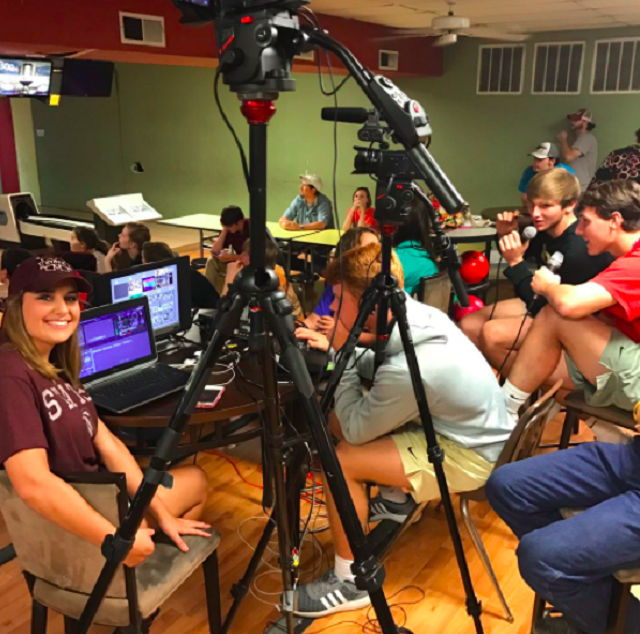Abbie Kate Hancock, Carter Bowen, Noah Fondren and Wheeler Eastman broadcasting a bowling game.
CULLMAN – Evolution is a necessity in the world of news and communication, no matter the level in which you are involved. Take ESPN for example. The worldwide leader in sports that broadcasts such huge events as the college football playoffs, Wimbledon and the Masters, started off broadcasting nothing more than slow pitch softball, strongman competitions and Magic: the Gathering tournaments, but they evolved. Such is the case with the Cullman High School Broadcast Network (CHSBN).
“The Bearcat Network, which has now evolved into the Cullman High School Broadcast Network, began as an extension of the original ‘CATS 55’ TV studio,” said John Drake, who oversees the CHSBN and who has taught the multimedia class at Cullman High School for the last 11 years. “My students in multimedia plus students in theater a few years back wanted to create a school and community variety show that could be shown during the Bearcat period. We ended up naming it the Bearcat News Network. We also used the Bearcats Sports Network some. So, we are still referred to as the BNN, Bearcat News, Bearcats News Network, Cullman Community TV or CATS 55 depending on when you started watching us, but currently we are sticking with the Cullman High School Broadcast Network.”
Despite the name changes over the years, and the students that have come and gone, the news and sports provided by the CHSBN have maintained the same high-quality programming that they were founded on.
“When I was in eighth grade at Cullman Middle School, I did the morning show and I really liked it,” Abbie Kate Hancock told the Cullman Tribune as she was working with Drake on a video package to submit to Mississippi State University. “That is when I decided I wanted to be a part of BNN (Bearcat News Network).”
The multimedia class and the CHSBN are open to any student who is interested in broadcasting.
“I have all types of students involved in my program,” said Drake of his willingness to teach anyone the broadcasting ropes. “Really anyone at CHS can be involved in the CHSBN if they are willing to learn and want to be a part of broadcasting.”
Not all students who are involved with the CHSBN plan on a career in broadcasting, like Zac Bell.
“I am going to Auburn for aerospace engineering actually,” Bell said on whether or not he planned on a career in broadcasting. “But I really enjoy graphic design and stuff like that. As well as the telling of the story and being able to edit (video). It is a lot of fun for me to make my own personal movie projects for my group of friends or some organizations that I am associated with. So I am sort of that free help to (CHSBN),” he said with a smile.
An important aspect of any TV or video broadcast is the camera operator, and that is where Bishop Lee comes in.
“For me, mainly not knowing the sport very well,” Lee answered when asked about the challenges he faced in a typical broadcast. “I am not a big sports guy so I kind of have to learn on the fly, what’s going on, but after a few minutes I usually get the hang of it.”
It takes a pretty big team to cover all of the events that the CHSBN does. The main broadcasting team is made up of 13 students who are dedicated to providing the quality programing that is produced by the CHSBN. The aforementioned Hancock, Bell and Lee, along with Carter Bowen, Wheeler Eastman, Noah Fondren, Ann Carol Braswell, Lexi Clemons, Dawson Culver, Caleb Coley, John Brown and John Guthrey make up the main broadcasting team.
“I really expect all students to be able to do all jobs,” Drake said when asked about each student’s role in the program. “Naturally, some are better at particular jobs. Commentating may be the most difficult. You have to know your subject and limit dead air time. That is tough to do sometimes. All the jobs are important though. You need good camera operators, audio and graphic technicians. It really takes a talented group to pull off a good broadcast. They also need to be able to think logically and be good troubleshooters. Something will go wrong and be a challenge with all broadcasts.”
Each broadcast has its own unique set of challenges but with numerous broadcasts now under their belt, the CHSBN has it down pat. From football and basketball to the newer sports such as bowling, they cover it all.
“We plan on covering all sports at Cullman High School,” said Drake. “We officially went on air last year during basketball season on Jan. 28, 2016. Since then, we have broadcast approximately 100 events. We have covered football, volleyball, bowling, swimming and both boys and girls this year. We also broadcast the Cullman High School graduation, theater, the city school board forum, awards assemblies and our Veterans Day celebration.”
A lot goes into a broadcast, like arriving early, sometimes the day before, to set up equipment and to make sure you get the perfect shot at the perfect time.
“A typical broadcast would have one to four camera operators, but we usually try to limit the broadcast to two camera operators, a computer graphics operator, one to two commentators and one person to be free to be the director of the broadcast,” Drake said of a typical setup. “We have actually had two broadcasts of two different sports going on at the same time. We broadcast baseball and soccer at the same time last year with two different crews simultaneously. This year we broadcast bowling and basketball at the same time. I also monitor the broadcasts on a mobile device or computer as they are happening to see how the final product looks to the general public.”
As the CHSBN continues to turn out a quality product that showcases not only Cullman High School sports, but all the happenings around CHS, other organizations are starting to take notice. According to Drake, along with covering at least one game, match or meet from each sport CHS offers, the CHSBN has been contracted by the Alabama High School Athletic Association and the National Federation of High Schools to cover several state events. This will include the Northwest Regional Basketball Tournament and the 1A-3A State Track Meet.
Drake adds that the network and, by extension, the class will prepare students for careers in the field of communication.
“Most importantly, it just flat out gives them an opportunity to experience something for real,” Drake said of the program he has helped build. “It is not something lectured to them, or a video to watch or book to read. They actually get to do something, that in turn allows them to learn something. They learn how to problem-solve on the fly and under pressure. They learn how to work together and get along. They learn that they have to stick with their job for the night and do it well or the whole production may be sub-par or fail entirely. They also learn what it is like to put out a good product versus a mediocre or bad product. They learn that the more organized and planned the broadcast is, the better it will turn out. Ultimately, they get to have fun while learning skills that they will use in whatever career path they end up choosing.”
If you have never sat down and watched a CHSBN production, do yourself a favor and make it a point to do so. The effort the students and Drake put in on a daily, and nightly, basis makes for a fantastic product. Being a fan of sports, I myself have watched several broadcasts, and believe me, you will not be disappointed.
Copyright 2016 Humble Roots, LLC. All Rights Reserved.





















